Abstract
To evaluate the impact of environmental factors on the occurrence of environmental mycobacteria, viable counts of mycobacteria were measured in samples of brook water collected from 53 drainage areas located in a linear belt crossing Finland at 63° north latitude. The numbers of mycobacteria were correlated with characteristics of the drainage area, climatic parameters, chemical and physical characteristics of the water, and counts of other heterotrophic bacteria in the water. The numbers of mycobacteria in the water ranged from 10 to 2,200 CFU/liter. The counts correlated positively (P < 0.001) with the presence of peatlands, precipitation data, chemical oxygen demand, water color, and concentrations of Fe, Al, Cu, Co, and Cr. The mycobacterial counts correlated negatively (P < 0.001) with water pH, whereas other heterotrophic bacterial counts lacked any correlation with pH. A linear regression model with four independent variables (i.e., peatlands in the drainage area, chemical oxygen demand, concentration of potassium, and pH) explained 83% of the variation in mycobacterial counts in brook waters. Our results suggest that acidification may enhance the growth of environmental mycobacteria.
Full text
PDF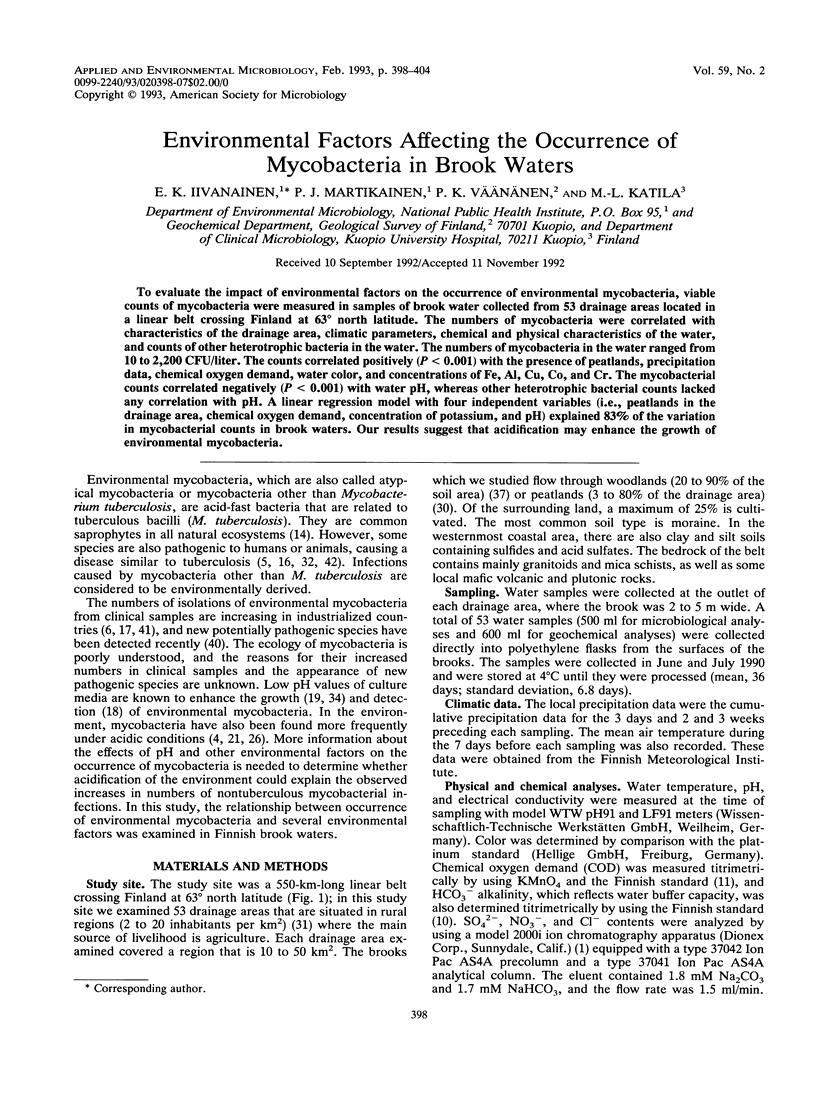
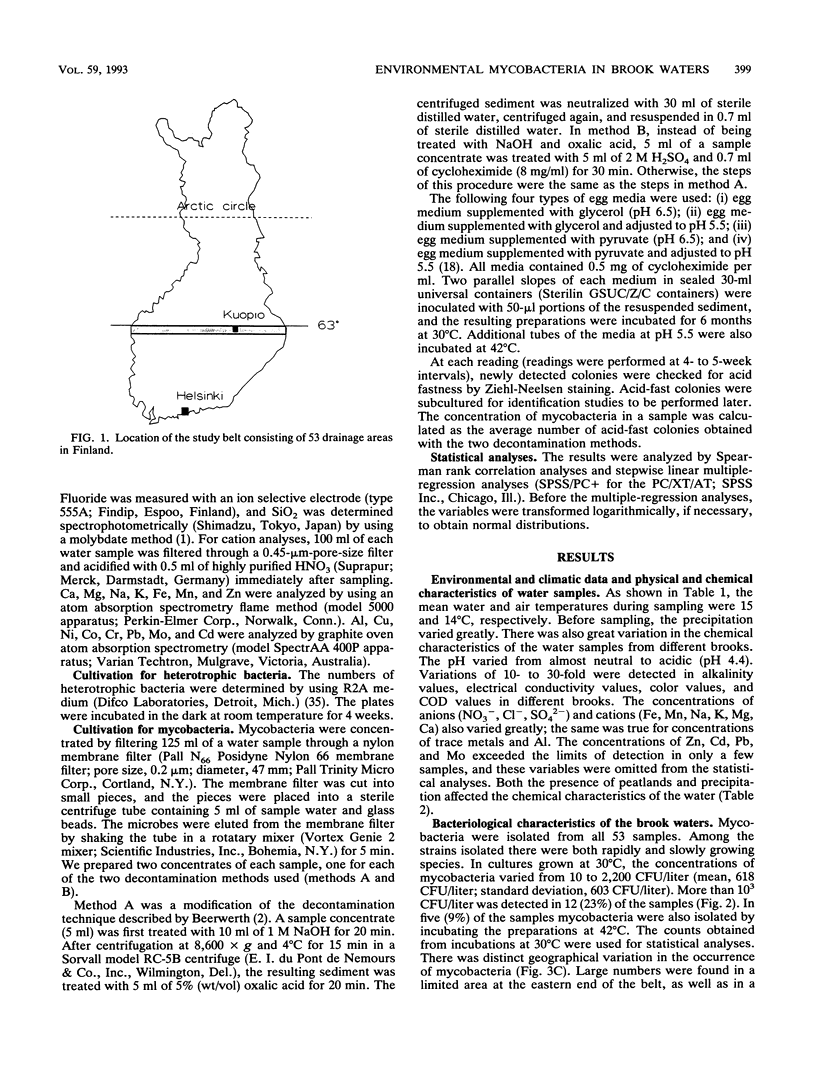
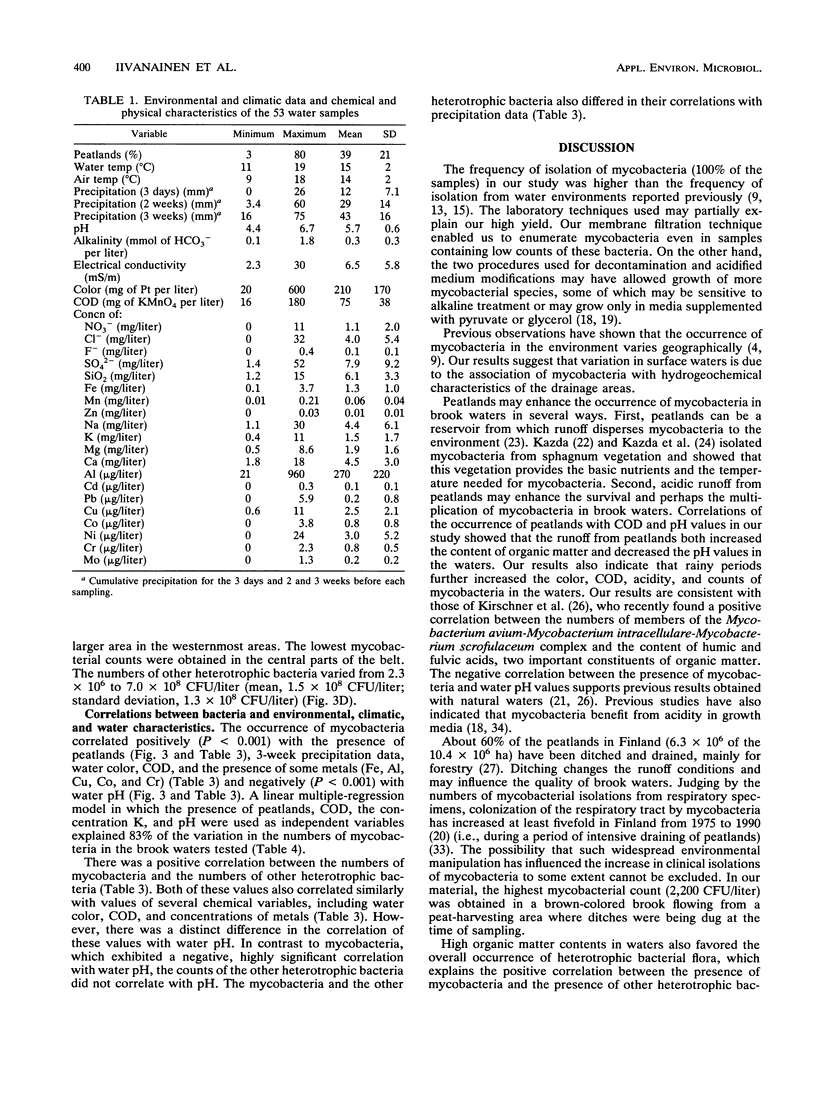
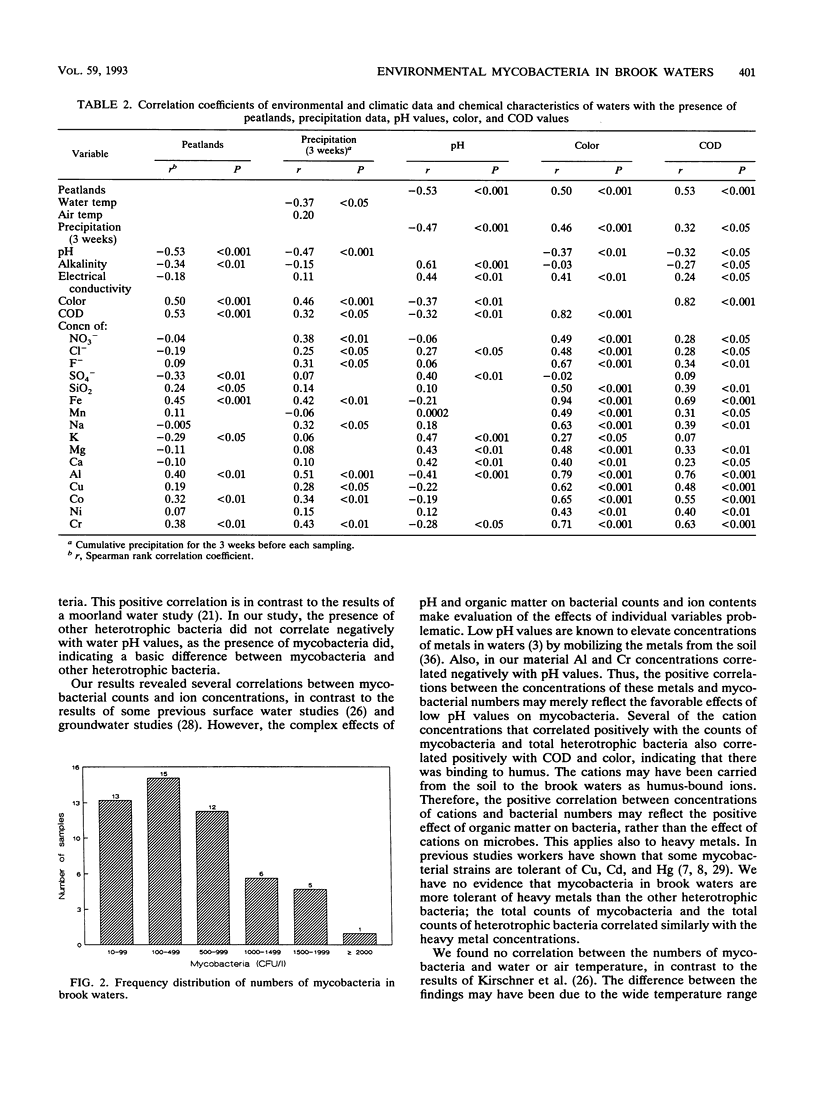
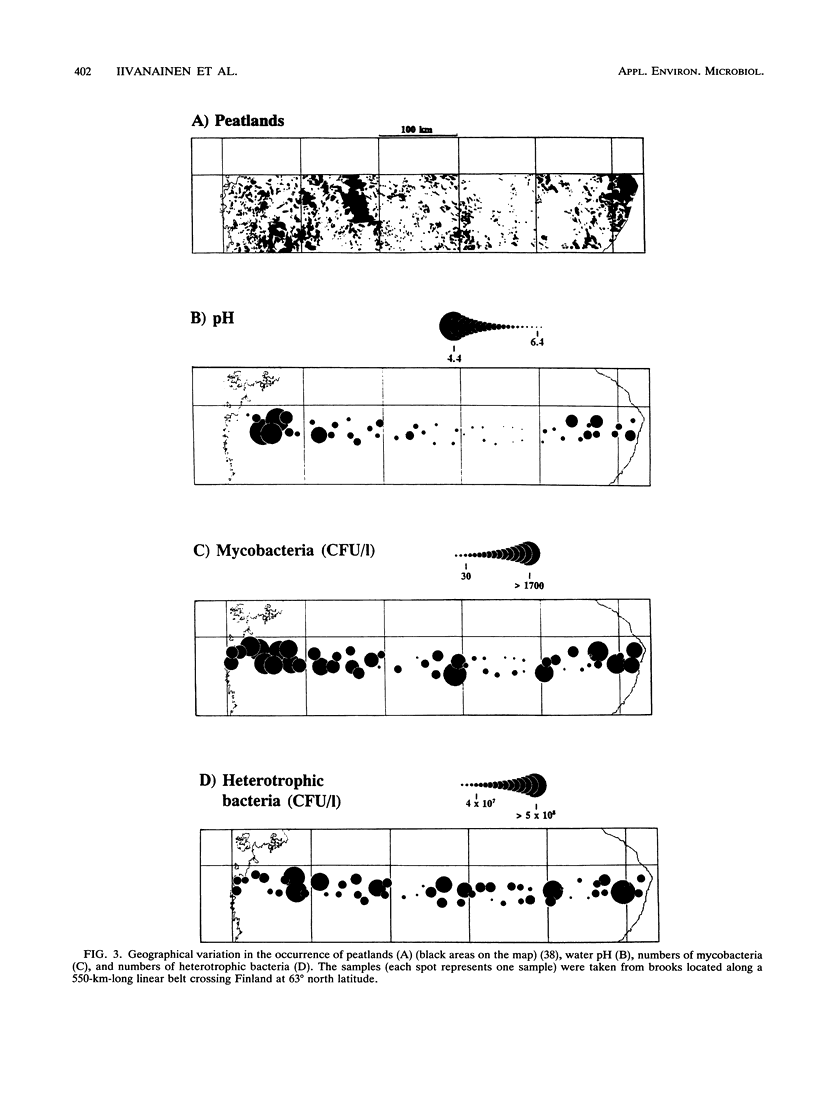
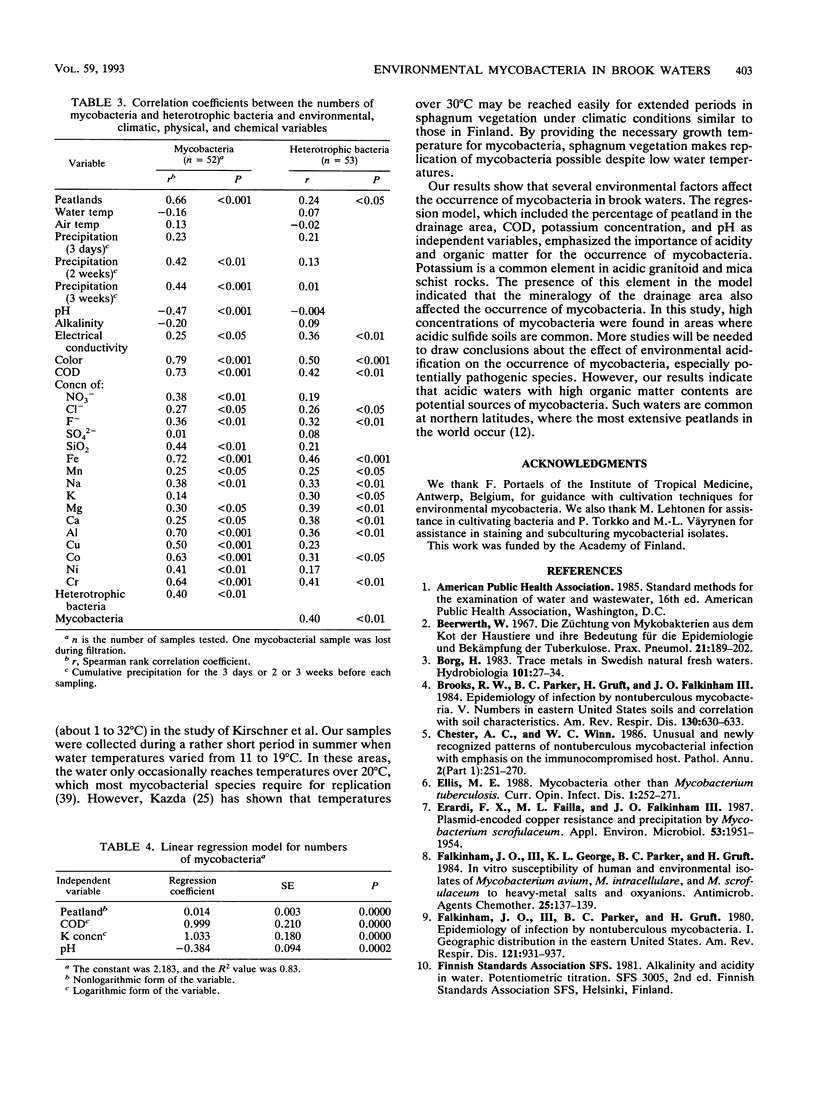
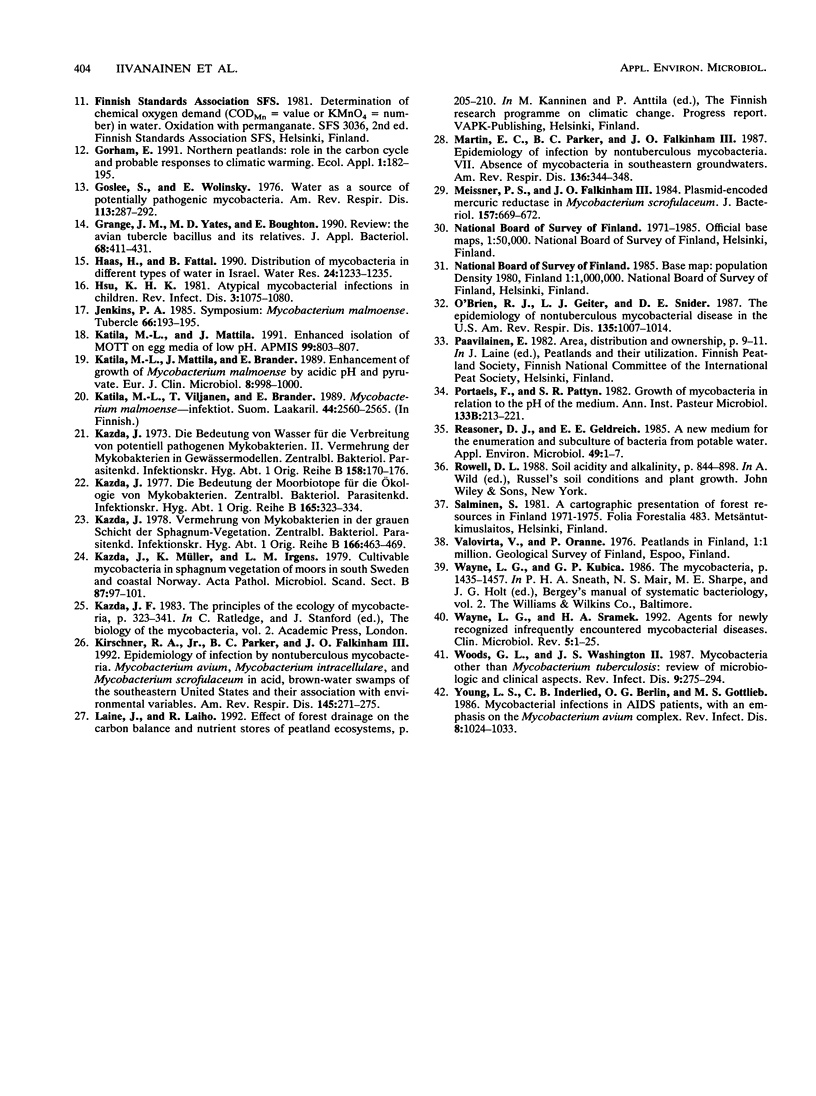
Selected References
These references are in PubMed. This may not be the complete list of references from this article.
- Beerwerth W. Die Züchtung von Mykobakterien aus dem Kot der Haustiere und ihre Bedeutung für die Epidemiologie und Bekämpfung der Tuberkulose. Prax Pneumol. 1967 Apr;21(4):189–202. [PubMed] [Google Scholar]
- Brooks R. W., Parker B. C., Gruft H., Falkinham J. O., 3rd Epidemiology of infection by nontuberculous mycobacteria. V. Numbers in eastern United States soils and correlation with soil characteristics. Am Rev Respir Dis. 1984 Oct;130(4):630–633. doi: 10.1164/arrd.1984.130.4.630. [DOI] [PubMed] [Google Scholar]
- Chester A. C., Winn W. C., Jr Unusual and newly recognized patterns of nontuberculous mycobacterial infection with emphasis on the immunocompromised host. Pathol Annu. 1986;21(Pt 1):251–270. [PubMed] [Google Scholar]
- Erardi F. X., Failla M. L., Falkinham J. O., 3rd Plasmid-encoded copper resistance and precipitation by Mycobacterium scrofulaceum. Appl Environ Microbiol. 1987 Aug;53(8):1951–1954. doi: 10.1128/aem.53.8.1951-1954.1987. [DOI] [PMC free article] [PubMed] [Google Scholar]
- Falkinham J. O., 3rd, George K. L., Parker B. C., Gruft H. In vitro susceptibility of human and environmental isolates of Mycobacterium avium, M. intracellulare, and M. scrofulaceum to heavy-metal salts and oxyanions. Antimicrob Agents Chemother. 1984 Jan;25(1):137–139. doi: 10.1128/aac.25.1.137. [DOI] [PMC free article] [PubMed] [Google Scholar]
- Falkinham J. O., 3rd, Parker B. C., Gruft H. Epidemiology of infection by nontuberculous mycobacteria. I. Geographic distribution in the eastern United States. Am Rev Respir Dis. 1980 Jun;121(6):931–937. doi: 10.1164/arrd.1980.121.6.931. [DOI] [PubMed] [Google Scholar]
- Goslee S., Wolinsky E. Water as a source of potentially pathogenic mycobacteria. Am Rev Respir Dis. 1976 Mar;113(3):287–292. doi: 10.1164/arrd.1976.113.3.287. [DOI] [PubMed] [Google Scholar]
- Grange J. M., Yates M. D., Boughton E. The avian tubercle bacillus and its relatives. J Appl Bacteriol. 1990 May;68(5):411–431. doi: 10.1111/j.1365-2672.1990.tb02892.x. [DOI] [PubMed] [Google Scholar]
- Hsu K. H. Atypical mycobacterial infections in children. Rev Infect Dis. 1981 Sep-Oct;3(5):1075–1080. [PubMed] [Google Scholar]
- Jenkins P. A. Mycobacterium malmoense. Tubercle. 1985 Sep;66(3):193–195. doi: 10.1016/0041-3879(85)90036-4. [DOI] [PubMed] [Google Scholar]
- Katila M. L., Mattila J., Brander E. Enhancement of growth of Mycobacterium malmoense by acidic pH and pyruvate. Eur J Clin Microbiol Infect Dis. 1989 Nov;8(11):998–1000. doi: 10.1007/BF01967574. [DOI] [PubMed] [Google Scholar]
- Katila M. L., Mattila J. Enhanced isolation of MOTT on egg media of low pH. APMIS. 1991 Sep;99(9):803–807. doi: 10.1111/j.1699-0463.1991.tb01263.x. [DOI] [PubMed] [Google Scholar]
- Kazda J. Die Bedeutung der Moorbiotope für die Okologie von Mykobakterien. Zentralbl Bakteriol Orig B. 1977 Dec;165(3-4):323–334. [PubMed] [Google Scholar]
- Kazda J. Die Bedeutung von Wasser für die Verbreitung von potentiell pathogenen Mykobakterien. II. Vermehrung der Mykobakterien in Gewässermodellen. Zentralbl Bakteriol Orig B. 1973 Oct;158(2):170–176. [PubMed] [Google Scholar]
- Kazda J., Müller K., Irgens L. M. Cultivable mycobacteria in sphagnum vegetation of moors in South Sweden and coastal Norway. Acta Pathol Microbiol Scand B. 1979 Apr;87B(2):97–101. doi: 10.1111/j.1699-0463.1979.tb02410.x. [DOI] [PubMed] [Google Scholar]
- Kazda J. Vermehrung von Mykobakterien in der grauen Schicht der Sphagnum-Vegetation. Zentralbl Bakteriol Orig B. 1978 May;166(4-5):463–469. [PubMed] [Google Scholar]
- Kirschner R. A., Jr, Parker B. C., Falkinham J. O., 3rd Epidemiology of infection by nontuberculous mycobacteria. Mycobacterium avium, Mycobacterium intracellulare, and Mycobacterium scrofulaceum in acid, brown-water swamps of the southeastern United States and their association with environmental variables. Am Rev Respir Dis. 1992 Feb;145(2 Pt 1):271–275. doi: 10.1164/ajrccm/145.2_Pt_1.271. [DOI] [PubMed] [Google Scholar]
- Martin E. C., Parker B. C., Falkinham J. O., 3rd Epidemiology of infection by nontuberculous mycobacteria. VII. Absence of mycobacteria in southeastern groundwaters. Am Rev Respir Dis. 1987 Aug;136(2):344–348. doi: 10.1164/ajrccm/136.2.344. [DOI] [PubMed] [Google Scholar]
- Meissner P. S., Falkinham J. O., 3rd Plasmid-encoded mercuric reductase in Mycobacterium scrofulaceum. J Bacteriol. 1984 Feb;157(2):669–672. doi: 10.1128/jb.157.2.669-672.1984. [DOI] [PMC free article] [PubMed] [Google Scholar]
- O'Brien R. J., Geiter L. J., Snider D. E., Jr The epidemiology of nontuberculous mycobacterial diseases in the United States. Results from a national survey. Am Rev Respir Dis. 1987 May;135(5):1007–1014. doi: 10.1164/arrd.1987.135.5.1007. [DOI] [PubMed] [Google Scholar]
- Portaels F., Pattyn S. R. Growth of mycobacteria in relation to the pH of the medium. Ann Microbiol (Paris) 1982 Sep-Oct;133(2):213–221. [PubMed] [Google Scholar]
- Reasoner D. J., Geldreich E. E. A new medium for the enumeration and subculture of bacteria from potable water. Appl Environ Microbiol. 1985 Jan;49(1):1–7. doi: 10.1128/aem.49.1.1-7.1985. [DOI] [PMC free article] [PubMed] [Google Scholar]
- Wayne L. G., Sramek H. A. Agents of newly recognized or infrequently encountered mycobacterial diseases. Clin Microbiol Rev. 1992 Jan;5(1):1–25. doi: 10.1128/cmr.5.1.1. [DOI] [PMC free article] [PubMed] [Google Scholar]
- Woods G. L., Washington J. A., 2nd Mycobacteria other than Mycobacterium tuberculosis: review of microbiologic and clinical aspects. Rev Infect Dis. 1987 Mar-Apr;9(2):275–294. doi: 10.1093/clinids/9.2.275. [DOI] [PubMed] [Google Scholar]
- Young L. S., Inderlied C. B., Berlin O. G., Gottlieb M. S. Mycobacterial infections in AIDS patients, with an emphasis on the Mycobacterium avium complex. Rev Infect Dis. 1986 Nov-Dec;8(6):1024–1033. doi: 10.1093/clinids/8.6.1024. [DOI] [PubMed] [Google Scholar]


